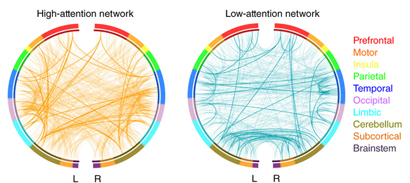Monday, 12 December 2016
Some Amazing Predictions Based on Brain Connectivity

This week, I’d like to tell you about two very interesting articles. The first, by Emily S. Finn and her colleagues, was published in the journal Nature Neuroscience in October 2015 and is entitled “Functional connectome fingerprinting: identifying individuals using patterns of brain connectivity.” As its title suggests, Finn’s research team successfully identified individuals from patterns not on their fingertips, but rather in their brains! Using a scanning method that produces images of the general functional connectivity among the various parts of a person’s brain, the researchers were able to predict with over 90% success which scan belonged to which of the 126 individuals in their study, simply by comparing the data from their scans. In the opinion of people who follow such research closely, this is an impressive result, because the identification could be made in at least two ways: by comparing the various individuals’ connectomes when their default mode networks were active and when their brains were shifting from default mode to a defined task.
The second study, published in the same journal in November 2016 by Monica D. Rosenberg and a number of colleagues who also participated in the first study, is entitled “A neuromarker of sustained attention from whole-brain functional connectivity.” In this second study, which used the same brain-imaging method as the first, the researchers showed that greater or lesser functional connectivity among certain parts of the brain corresponded very precisely to an individual’s ability to pay sustained attention to a task.
Moreover, models developed from these patterns of better or poorer connectivity for sustained-attention tasks could even predict the attentional capabilities of new individuals. In other words, the researchers scan your brain, analyze the patterns of functional connectivity (which parts of your brain tend to “work together”) in the scan, and then use these models to predict how well you will be able to pay sustained attention in a task that they then have you perform. And when you perform the task, your results confirm their prediction!
In closing, I’d like to acknowledge the impressive graphics illustrating these articles. These illustrations let you visually grasp the particular signature of each type of connectome at a glance. The colour coding also gives you some idea of the main large interconnected regions of each hemisphere of the brain.
![]() A Needle in the Connectome: Neural ‘Fingerprint’ Identifies Individuals with ~93% accuracy
A Needle in the Connectome: Neural ‘Fingerprint’ Identifies Individuals with ~93% accuracy
![]() Functional connectome fingerprinting: identifying individuals using patterns of brain connectivity
Functional connectome fingerprinting: identifying individuals using patterns of brain connectivity
![]() Linking sustained attention to brain connectivity
Linking sustained attention to brain connectivity
![]() A neuromarker of sustained attention from whole-brain functional connectivity
A neuromarker of sustained attention from whole-brain functional connectivity
From the Simple to the Complex | No comments







